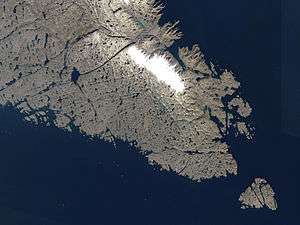Tanfield Valley
Tanfield Valley, also referred to as Nanook, is an archaeological site located on the southernmost projection of Baffin Island in the Canadian territory of Nunavut. It is possible that the site was known to Pre-Columbian Norse explorers from Greenland and Iceland. It may be in the region of Helluland,[1] spoken of in the Icelandic sagas (Greenland Saga and Saga of Erik the Red).[2][3][4]

The Helluland Archaeology Project is a research initiative that was set up at the Canadian Museum of Civilization, now the Canadian Museum of History, to investigate the possibility of an extended Norse presence on Baffin Island with trading with the indigenous Dorset people.[5] It is now on hiatus following Patricia Sutherland's ouster from the museum in 2012.[3][6] Excavations led by Sutherland at Tanfield Valley found possible evidence[7][8] of medieval Norse textiles, metallurgy and other items of European-related technologies. Wooden artifacts from Dorset sites include specimens which bear a close resemblance to Norse artifacts from Greenland. Pelts from Eurasian rats have also been discovered.[9][10]
In 2018, Michele Hayeur Smith of Brown University, who specializes in the study of ancient textiles, wrote that she does not think the ancient Arctic people, the Dorset and Thule, needed to be taught how to spin yarn, remarking "It's a pretty intuitive thing to do."[7][11] In 1992, Elizabeth Wayland Barber wrote that a piece of three-ply yarn that dates to the Paleolithic era, that ended about 10,000 BP, was found at the Lascaux caves in France. This yarn consisted of three s-twist strands that were z-plied, much like the way yarn is made now.[8] The eight sod buildings and artifacts found in the 1960s at L'Anse aux Meadows, located on the northern tip of Newfoundland, remains the only confirmed Norse site in North America outside of those found in Greenland.
Moreau Maxwell (1918-1998), professor and curator of Anthropology at Michigan State University, had previously researched the site in his study of the prehistory of Baffin island, the findings of which were summarized in his publication Prehistory of the Eastern Arctic (1985).[12]
References
- "The Saga of Erik the Red". The Icelandic Saga Database. Sveinbjörn Þórðarson. Retrieved 12 January 2019.
This land they gave name to, and called it Helluland (stone-land).
- Heather Pringle (November 2012). "Vikings and Native Americans". National Geographic. 221 (11). Retrieved January 28, 2013.
- Andrew Hamilton (February 8, 2013). "The Medieval Norse on Baffin Island". Counter-Currents Publishing. Retrieved October 18, 2015.
- "World of the West Norse: Greenland to Baffin". Cornell University Library. December 8, 2015. Retrieved January 20, 2016.
- "Helluland Archaeology Project". Canadian Museum of History. Retrieved October 18, 2015.
- Stueck, Wendy; Taylor, Kate (4 December 2014). "Canadian Museum of History reveals researcher was fired for harassment". The Globe and Mail. Retrieved 3 January 2019.
On the program, host Carol Off interviewed Dr. Sutherland […] Off asked Dr. Sutherland whether she might have been fired from the Canadian Museum of Civilization (which was renamed the Canadian Museum of History last year) because her research was out of step with government views of Canadian history. Sutherland agreed […]
- Weber, Bob (22 July 2018). "Ancient Arctic people may have known how to spin yarn long before Vikings arrived". Old theories being questioned in light of carbon-dated yarn samples. CBC. Retrieved 2 January 2019.
… Michele Hayeur Smith of Brown University in Rhode Island, lead author of a recent paper in the Journal of Archaeological Science. Hayeur Smith and her colleagues were looking at scraps of yarn, perhaps used to hang amulets or decorate clothing, from ancient sites on Baffin Island and the Ungava Peninsula. The idea that you would have to learn to spin something from another culture was a bit ludicrous," she said. "It's a pretty intuitive thing to do.
- Barber, Elizabeth Wayland (1992) Prehistoric Textiles: The Development of Cloth in the Neolithic and Bronze Ages with Special Reference to the Aegean, Princeton University Press, "We now have at least two pieces of evidence that this important principle of twisting for strength dates to the Palaeolithic. In 1953, the Abbé Glory was investigating floor deposits in a steep corridor of the famed Lascaux caves in southern France […] a long piece of Palaeolithic cord […] neatly twisted in the S direction […] from three Z-plied strands […]" ISBN 0-691-00224-X
- Heather Pringle (October 19, 2012). "Evidence of Viking Outpost Found in Canada". National Geographic News. National Geographic Society. Retrieved January 28, 2013.
- Margo Pfeiff (July 29, 2013). "When the Vikings were in Nunavut". Up Here. Archived from the original on April 18, 2016. Retrieved April 6, 2016.
- Smith, Michèle Hayeur; Smith, Kevin P.; Nilsen, Gørill (2018). "Journal of Archaeological Science" (PDF). Dorset, Norse, or Thule? Technological transfers, marine mammal contamination, and AMS dating of spun yarn and textiles from the Eastern Canadian Arctic. Elsevier. Retrieved 12 January 2019.
However, the date received on Sample 4440b from Nanook clearly indicates that sinew was being spun and plied at least as early, if not earlier, than yarn at this site. We feel that the most parsimonious explanation of this data is that the practice of spinning hair and wool into plied yarn most likely developed naturally within this context of complex, indigenous, Arctic fiber technologies, and not through contact with European textile producers.
- William A. Lovis (March 1998). "Moreau Sanford Maxwell". Society for American Archaeology Bulletin. 16 (2).
Related Reading
- Maxwell, Moreau (1985) Prehistory of the Eastern Arctic (Academic Press) ISBN 978-0124812703
- Sutherland, Patricia (2015) The Helluland Archaeological Project